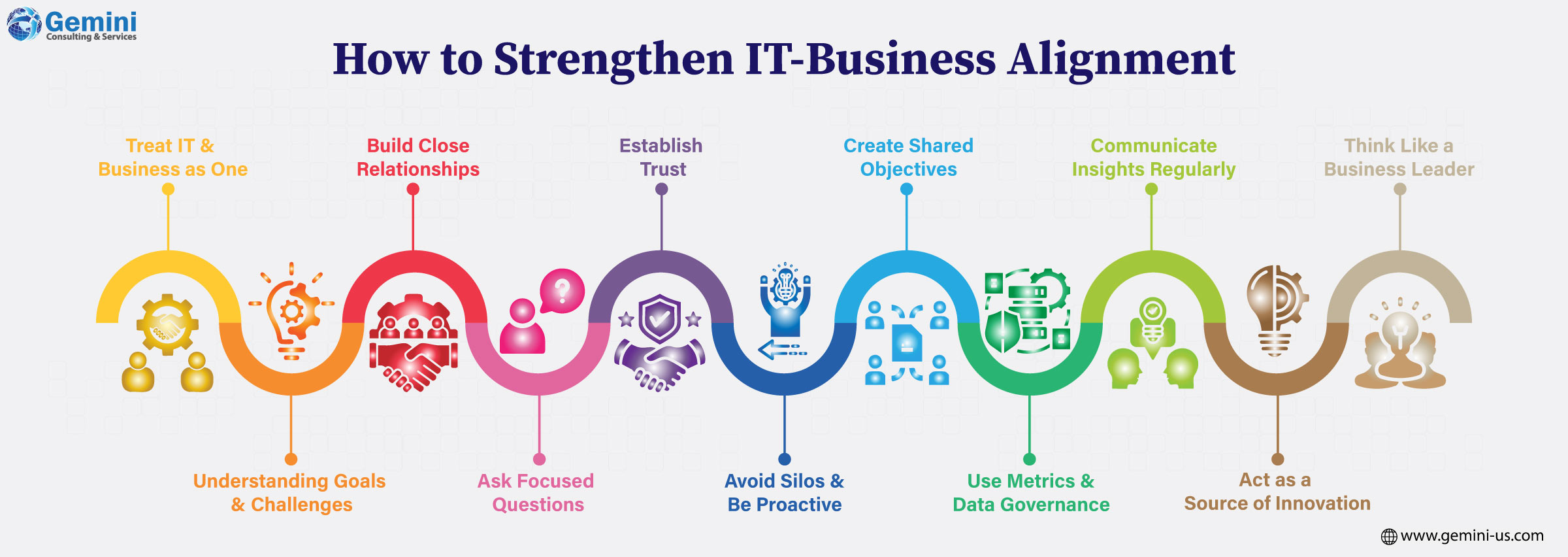When IT and business leaders operate in isolation or follow misaligned objectives, it can negatively impact the whole organization. Establishing a close, collaborative relationship between IT and business is essential for sustained success
Most executives now understand that technology underpins nearly every aspect of modern business, from storing documents to running meetings. Aligning IT strategy with business objectives ensures resources are maximized, operations run efficiently, and teams work toward shared goals.
Why Business and IT Alignment Matters
In the past, IT was often treated as a separate support function. Today, technology is central to daily operations, enabling remote work, lowering costs, and improving reliability. Yet many organizations still neglect to integrate IT into strategic planning.
Strategic alignment means structuring every department’s activities around a central business goal. This ensures that all teams remain focused, even during times of disruption. Connecting IT with business strategy leads to better data-driven decisions, stronger resource allocation, and improved agility.
The challenge is that leaders sometimes focus only on their own function’s contribution to the organization’s objectives. True alignment requires viewing all departments, particularly IT and business units, as interdependent parts of the same strategy.

1. Treat IT and Business as One
IT and business strategies are inseparable. A strong IT roadmap should be built alongside business strategy, with IT leaders actively involved in decision-making at the highest level.
2. Understand Each Function’s Goals and Challenges
IT leaders must learn the priorities, pain points, and goals of other departments. Agility and adaptability are essential to respond to changes quickly and support the entire organization.
3. Build Close Relationships
Alignment thrives on open, ongoing dialogue. For example, when a business leader wants to explore AI, IT should explain requirements, such as the need for large datasets, and help design a workable plan.
4. Ask Business-Focused Questions
Rather than focusing only on technical details, IT leaders should ask business leaders about market trends and challenges, then identify where technology can add value.
5. Establish Trust
Effective partnerships are built on a base of shared objectives and respect. When trust is present, decisions happen faster, creativity is encouraged, and excessive planning becomes unnecessary.”
6. Avoid Silos and Be Proactive
Without alignment, silos form, causing miscommunication and wasted effort. IT should anticipate business needs and be part of long-term planning, rather than reacting to requests.
7. Create Shared Objectives
Both IT and business leaders need a seat at each other’s strategy tables. Joint forums can set shared objectives and measure progress regularly.
8. Use Metrics and Data Governance
Measure alignment through KPIs such as collaboration, agility, and strategic impact. Maintain accurate, consistent master data to support informed decision-making and AI readiness.
9. Communicate Insights Regularly
Regular meetings must be scheduled to communicate clearly about the objectives, and this ensure IT initiatives are aligned with business goals. Embedding IT staff within business units can foster better understanding and integration.
10. Act as a Source of Innovation
IT should introduce new technologies and improvements that business leaders may not yet be aware of, driving transformation and incremental gains.
11. Think Like a Business Leader
IT executives must understand business strategy deeply, participate in decision-making, and maintain constant dialogue with their counterparts.
Steps to Achieve Alignment
I. Build Trust and Communication
Foster a culture of mutual respect and open communication, avoiding jargon when speaking across departments. Mentorship programs and informal interactions can strengthen cross-departmental understanding.
II. Identify Needs and Make a Plan
Assess how well IT currently supports business objectives, identify gaps, and work with business leaders to address them through collaborative planning.
III. Evaluate and Adapt
Monitor the effectiveness of your plan and adjust as business and technology evolve. IT goals should always serve business objectives.

- Competitive Advantage: Aligning technology with business goals speeds time-to-market, improves efficiency, and avoids wasted resources.
- Higher ROI: Better collaboration, faster execution, and reduced unnecessary spending lead to increased returns.
- Smarter Decisions: Data-driven strategies and improved cross-departmental communication enable better decision-making.
Risks of Misalignment
If an enterprise is unable to align technological investments and business strategies, it can lead to:
- Miscommunication: Without understanding each other’s work, departments may misinterpret needs and priorities.
- Outdated Technology: Enterprises may tend to retain legacy systems that are inefficient, leading to reduced productivity.
- Unnecessary Spending: Organizations may purchase technology that does not serve core objectives.
This disconnect can result in inefficiency, security risks, and lost opportunities.
What Business-IT Alignment Really Means
Aligning business and IT is a continuous effort to embed technology into the heart of an organization’s strategy. It demands cooperation, mutual understanding, and a move toward seeing IT as a strategic partner rather than just a support role.
When IT is treated as an integral partner, solutions are designed with business revenue, efficiency, and compliance in mind. This approach improves customer service, optimizes costs, manages risks, and strengthens competitive positioning.
With over a decade of experience in consulting and technology implementation, Gemini Consulting & Services can help enterprises align their IT strategy with business objectives. Contact us to know how our experts can join hands with your team to unlock maximum value from IT investment.
Achieving Alignment in Small Businesses
For small organizations, achieving full alignment can be difficult with limited in-house IT staff. Partnering with a managed service provider (MSP) can provide the strategic guidance, technical expertise, and administrative support needed.
A managed service provider can:
- Regularly review your strategy to make sure your technology continues to support the organization’s goals.
- Create a long-term technology plan and budget to prepare for upcoming requirements.
- Deliver continuous system upkeep, user support, and proactive performance monitoring.
By integrating IT into strategic planning, small businesses can gain enterprise-level efficiency, scalability, and innovation without the cost of a large IT department.



